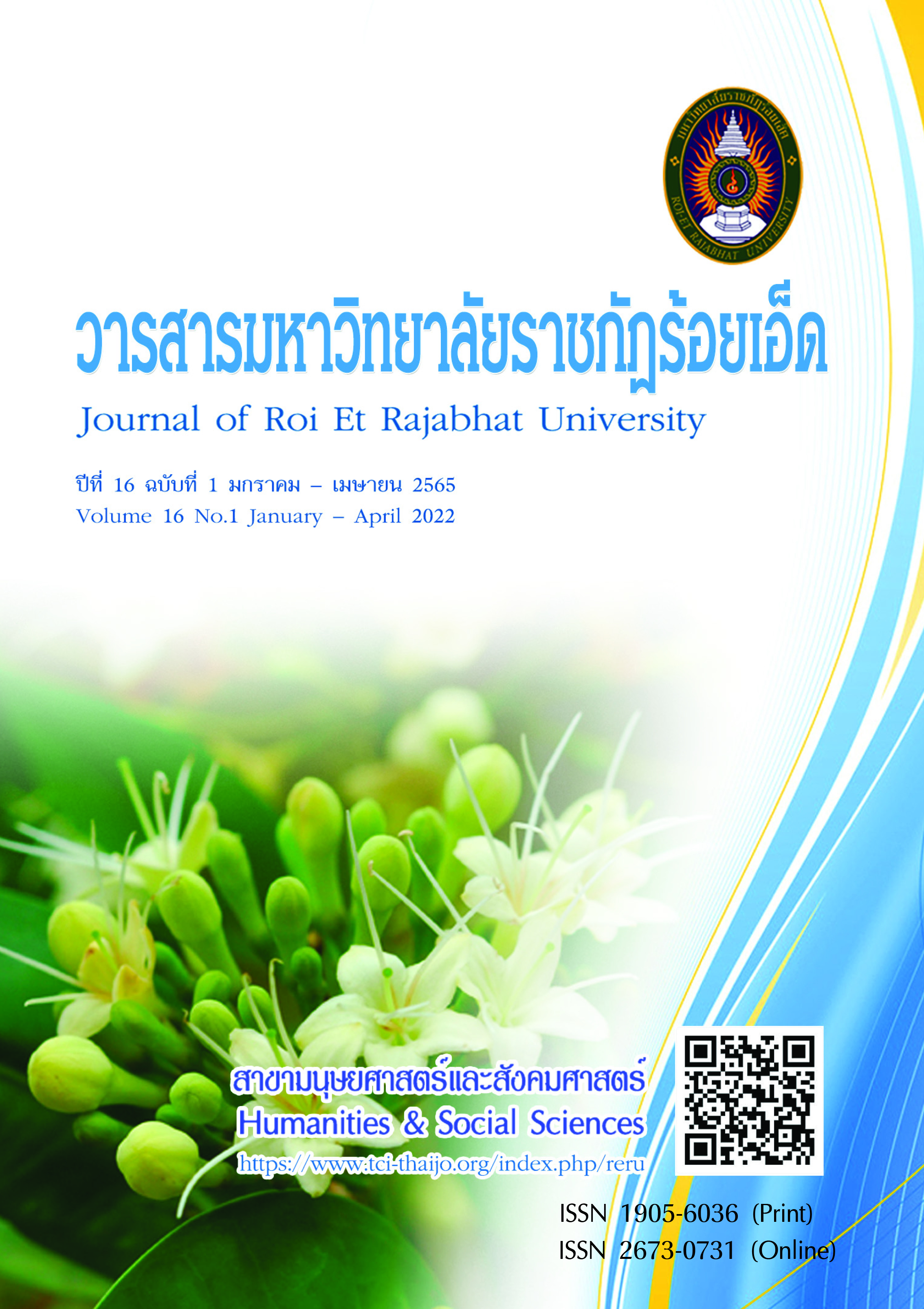Heet-Kong Cultural Technology for Appropriate Governance of Community Ways: A Case Study of Songyae Village, Khamtoei Subdistrict, Thaicharoen District, Yasothon Province
Keywords:
Heet Kong culture, Thai-Lao ethnicity, Community waysAbstract
The objectives of this research were 1) to study the technology of Heet Kong culture for appropriate governance of community ways of life at Song Yae village. 2) to analyze the co-cultural technology
for peace and sustainability of the Heet Kong culture technology as a guideline in religious differences
and 3) to present a model of peaceful coexistence, even though the people of the community believe
in different religions. This research was an ethnographically qualitative research. The case study was collected through in-depth interviews from villagers of Khamtoei subdistrict, Thaicharoen district, Yasothon province. The results showed that 1. Song Yae community, Yasothon province had religious differences, i.e. Buddhism and Christianity, providing the value of Heet Kong culture and tradition through loveliness and unity, harmony and family warmness, and creating the order in the community and being able
to coexist with different religions. They believe that the doctrines of Buddhism and Christianity have been practiced since their ancestors and adjusted from the basics and practices to be consistent with the changes of the community way of Heet Kong culture technology for proper governance of leaders in adopting
the Heet Kong culture and spreading it through the ages in communities of both Buddhism and Christianity.
It did not affect the conversion of Heet Kong, and the loveliness, harmony, reconciliation, and respect
for the elders were diminished. 2. The introduction of Heet Kong as a common cultural technology approach for peace and sustainability for a proper government, the strategy of loveliness, unity, and harmony should be used. In helping to preserve and restore technology to the Heet Kong culture and strategies
of technology, the coexistence despite different religions could create a community way becoming
a model community and cultural technology for the proper governance for the peace and sustainability
of technology, culture, Heet Kong of different religions in the community and nation and 3. The model
of difference in Buddhism and Christianity together with loveliness, goodness, forgiveness, and gratitude
to our fellow human beings are the foundation of sustainable development.
References
จักษ์ พันธ์ชูเพชร. (2551). การเมืองการปกครองไทย : จากยุคสุโขทัยสู่สมัยทักษิณ (พิมพ์ครั้งที่ 6). ปทุมธานี: มายด์พับลิชชิ่ง.
จารุบุตร เรืองสุวรรณ. (2521). ขนบธรรมเนียมประเพณีระบอบการปกครองของชาวอีสานสมัยเก่า. มหาสารคาม:
มหาวิทยาลัยศรีนครินทรวิโรฒ.
จีระเดช ดิสกะประกาย. (2553). ตนสุวรรณภูมิ. กรุงเทพฯ: เอเอสทีวีผู้จัดการ.
ปริญ รสจันทร์. (2559). การสร้างความปรองดองระหว่างสยามและท้องถิ่นหลังความขัดแย้งกรณีกบฏผู้มีบุญอีสาน
พุทธศักราช 2444-2455. วารสารมหาวิทยาลัยราชภัฏร้อยเอ็ด, 10(2), 181-190.
ยุวดี หัสดี. (2563). การพัฒนาการมีส่วนร่วมตามแนวคิดเศรษฐกิจสร้างสรรค์ในการจัดการท่องเที่ยว ถนนสายวัฒนธรรม ชุมชนหมื่นสาร จังหวัดเชียงใหม่. วารสารมหาวิทยาลัยราชภัฏร้อยเอ็ด, 14(2), 24-34.
วิโรจน์ สุวรรณคีรี. (2561). เทคโนโลยีวัฒนธรรมการปกครองเพื่อสันติสุขที่สัมพันธ์กับข้อขะลำของกลุ่มชาติพันธุ์ลาวแง้ว ในราชอาณาจักรไทยและในสาธารณรัฐประชาธิปไตยประชาชนลาว. ดุษฎีนิพนธ์ ปรัชญาดุษฎีบัณฑิต สาขาวิชายุทธศาสตร์การพัฒนาภูมิภาค (เทคโนโลยีที่เหมาะสมเพื่อการพัฒนาที่ยั่งยืน). สุรินทร์: มหาวิทยาลัย
ราชภัฏสุรินทร์.
สุวิทย์ ธีรศาศวัต. (2549). กบฏผู้มีบุญอีสาน 2444-45 กับจดหมายลูกโซ่ฉบับแรกของเมืองไทย. ศิลปวัฒนธรรม, 28(1), 82-95.
โสภี อุ่นทะยา. (2551). การให้ความหมายและกลไกการสร้างความสัมพันธ์บนพื้นที่พรมแดนไทย-ลาว จังหวัดมุกดาหาร-แขวงสะหวันนะเขต. วารสารวิชาการ วิถีสังคมมนุษย์, 1(พิเศษ เดือนมกราคม- มิถุนายน 2556), 73-89.
อำนาจ พรหมกัลป์. (2560). กฎหมายโบราณอีสานในสยาม: การปกครองท้องถิ่นสาเกตุนคร พ.ศ. 2397- 2414.
วารสารวิชาการ ฉบับภาษาไทย สาขามนุษยศาสตร์ สังคมศาสตร์ และศิลปะ, 10(1), 647-655.
อัจฉรา ภาณุรัตน์. (2555). เศรษฐกิจและนิเวศวิทยาสิ่งแวดล้อม: ขาดทุนคือกำไร. สุรินทร์: มหาวิทยาลัยราชภัฏสุรินทร์.
Downloads
Published
How to Cite
Issue
Section
License
Copyright (c) 2022 Roi Et Rajabhat University

This work is licensed under a Creative Commons Attribution-NonCommercial-NoDerivatives 4.0 International License.
บทความที่ได้รับการตีพิมพ์เป็นลิขสิทธิ์ของวารสารมหาวิทยาลัยราชภัฎร้อยเอ็ด
ข้อความที่ปรากฏในบทความแต่ละเรื่องในวารสารวิชาการเล่มนี้เป็นความคิดเห็นส่วนตัวของผู้เขียนแต่ละท่านไม่เกี่ยวข้องกับมหาวิทยาลัยราชภัฎร้อยเอ็ด และคณาจารย์ท่านอื่นๆในมหาวิทยาลัยฯ แต่อย่างใด ความรับผิดชอบองค์ประกอบทั้งหมดของบทความแต่ละเรื่องเป็นของผู้เขียนแต่ละท่าน หากมีความผิดพลาดใดๆ ผู้เขียนแต่ละท่านจะรับผิดชอบบทความของตนเองแต่ผู้เดียว





